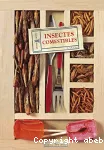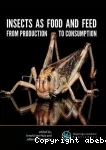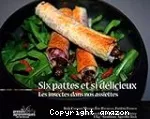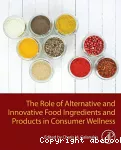Adresse
Infodoc : Réseau des bibliothèques et centres de documentation d'AgroParisTechFrance
contact

Catégories
|
RAMEAU , Nom commun , Insectes comestibles
Insectes comestiblesSynonyme(s)Insectes (aliment)Relation(s)
|
Documents disponibles dans cette catégorie (17)
 Ajouter le résultat dans votre panier
Visionner les documents numériques
Faire une suggestion Affiner la recherche Interroger des sources externes
Ajouter le résultat dans votre panier
Visionner les documents numériques
Faire une suggestion Affiner la recherche Interroger des sources externes
 Livre
Livre978-3-030-32951-81 vol. (314 p.)
1 vol. (314 p.)ISBN : 978-3-030-32951-8 
 Thèse1 vol. (176 p.)
Thèse1 vol. (176 p.)
1 vol. (176 p.)
 Bulletin
Bulletin
 Bulletin
Bulletin
 Livre
Livre978-3-030-08900-91 vol. (XVII-479 p.)
1 vol. (XVII-479 p.)ISBN : 978-3-030-08900-9 
 Livre
Livre978-3-030-22521-61 vol. (XIV-120 p.)
1 vol. (XIV-120 p.)ISBN : 978-3-030-22521-6 
 Livre
Livre978-0-12-814564-71 vol. (XIV-391 p.)
1 vol. (XIV-391 p.)ISBN : 978-0-12-814564-7 
 Livre19,90 EUR
Livre19,90 EUR978-2-915810-81-31 vol. (152 p.)
1 vol. (152 p.)Prix : 19,90 EUR ISBN : 978-2-915810-81-3 
 Livre16 EUR
Livre16 EUR978-2-7592-2454-81 vol. (183 p.)
1 vol. (183 p.)Prix : 16 EUR ISBN : 978-2-7592-2454-8 
 Livre6,80 EUR
Livre6,80 EUR978-2-330-13514-01 vol. (149 p.)
1 vol. (149 p.)Prix : 6,80 EUR ISBN : 978-2-330-13514-0 
 Livre
Livre
 Livre
Livre978-90-8686-296-21 vol. (447 p.)
1 vol. (447 p.)ISBN : 978-90-8686-296-2 
 Bulletin
Bulletin
 Livre
Livre978-0-12-800605-41 vol. (XXI-514 p.)
1 vol. (XXI-514 p.)ISBN : 978-0-12-800605-4 
 Livre24 EUR
Livre24 EUR978-2-7535-5142-81 vol. (434 p.-[32] p. de pl.)
1 vol. (434 p.-[32] p. de pl.)Prix : 24 EUR ISBN : 978-2-7535-5142-8 
 Livre
Livre978-2-87016-130-21 vol. (72 p.)
1 vol. (72 p.)ISBN : 978-2-87016-130-2 
 Livre
Livre978-0-12-816453-21 vol. (XV-348 p.)
1 vol. (XV-348 p.)ISBN : 978-0-12-816453-2





